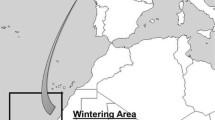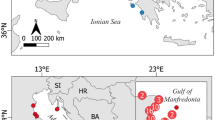Abstract
Variation in the age at first reproduction may have important implications for growth and dynamics of populations, but these potential impacts remain virtually unexplored. By using 26 years of data from a marked colony of blue-footed boobies Sula nebouxii (Milne-Edwards), we tested whether survival of early recruits is lower in comparison to late recruits, and investigate how different recruiting ages contribute to the persistence of the population. In addition, we simulated changes in the age at recruitment and estimated their impact on population fitness. Our analyses of 1310 capture–recapture histories revealed that the younger males and females initiated reproduction within the first 6 years of life, the lower were their mean annual survival probabilities. Survival did not differ between the sexes and the impact of recruiting age on survival was similar for males and females. Each additional year that male and female boobies delayed the start of reproduction meant an increase of roughly 2 % in their annual survival rates. Male and female recruits 2–5 years old contributed the same to the rate of population growth (λ) regardless of their particular age, but the contribution to population growth started to decline from age 6 years. According to our simulations, delaying reproduction beyond 5 years in the case of females, and beyond 6 years in the case of males, would negatively affect this booby population. Therefore, we suggest that there is selection against recruiting beyond 5–6 years old. This study adds to the nascent empirical literature on long-term fitness consequences of variation in the age at first reproduction in long-lived species, and provides insights into evolution of early and late reproduction and trade-offs from a demographic perspective.



Similar content being viewed by others
References
Akaike H (1998) Information theory and an extension of the Maximum Likelihood Principle. In: Parzen E, Tanabe K, Kitagawa G (eds) Selected Papers of Hirotugu Akaike SE-15. Springer, New York, pp 199–213
Amstrup SC, McDonald TL, Manly BFJ (2005) Handbook of Capture-Recapture Analysis. Princeton University Press, New Jersey
Ancona S, Drummond H (2013) Life history plasticity of a tropical seabird in response to El Niño anomalies during early life. PLoS One 8:e72665. doi:10.1371/journal.pone.0072665
Ancona S, Sánchez-Colón S, Rodríguez C, Drummond H (2011) El Niño in the Warm Tropics: local sea temperature predicts breeding parameters and growth of blue-footed boobies. J Anim Ecol 80:799–808. doi:10.1111/j.1365-2656.2011.01821.x
Aubry LM, Koons DN, Monnat J-Y, Cam E (2009) Consequences of recruitment decisions and heterogeneity on age-specific breeding success in a long-lived seabird. Ecology 90:2491–2502
Beamonte-Barrientos R, Velando A, Drummond H, Torres R (2010) Senescence of maternal effects: aging influences egg quality and rearing capacities of a long-lived bird. Am Nat 175:469–480. doi:10.1086/650726
Becker PH, Bradley JS (2007) The role of intrinsic factors for the recruitment process in long-lived birds. J Ornithol 148:377–384. doi:10.1007/s10336-007-0157-x
Benton TG, Grant A (1999) Elasticity analysis as an important tool in evolutionary and population ecology. Trends Ecol Evol 14:467–471. doi:10.1016/S0169-5347(99)01724-3
Benton TG, Grant A (2000) Evolutionary fitness in ecology: comparing measures of fitness in stochastic, density-dependent environments. Evol Ecol Res 2:769–789
Blomquist GE (2009) Trade-off between age of first reproduction and survival in a female primate. Biol Lett 5:339–342
Brommer JE, Merilä J, Kokko H (2002) Reproductive timing and individual fitness. Ecol Lett 5:802–810. doi:10.1046/j.1461-0248.2002.00369.x
Burnham KP, Anderson DR (2002) Model selection and multimodel inference: a practical information-theoretic approach. Springer, New York
Caswell H (2001) Matrix population models: construction, analysis, and interpretation. Sinauer Associates, Inc., Sunderland
Charmantier A, Perrins C, McCleery RH, Sheldon BC (2006) Quantitative genetics of age at reproduction in wild swans: support for antagonistic pleiotropy models of senescence. Proc Natl Acad Sci USA 103:6587–6592
Charnov EL (1990) On evolution of age of maturity and the adult lifespan. J Evol Biol 3:139–144
Clobert J (1995) Capture–recapture and evolutionary ecology: a difficult wedding? J Appl Stat 22:989–1008. doi:10.1080/02664769524757
Clutton-Brock TH, Huchard E (2013) Social competition and selection in males and females. Philos Trans R Soc B Biol Sci 368:20130074
Cole LC (1954) The population consequences of life history phenomena. Q Rev Biol 29:103–137
Cox R, Calsbeek R (2009) Sexually antagonistic selection, sexual dimorphism, and the resolution of intralocus sexual conflict. Am Nat 173:176–187. doi:10.1086/595841
Crone EE, Menges ES, Ellis MM et al (2011) How do plant ecologists use matrix population models? Ecol Lett 14:1–8. doi:10.1111/j.1461-0248.2010.01540.x
De Kroon H, Plaisier A, van Groenendael J, Caswell H (1986) Elasticity: the relative contribution of demographic parameters to population growth rate. Ecology 67:1427–1431
De Kroon H, Van Groenendael J, Ehrlén J (2000) Elasticities: a review of methods and model limitations. Ecology 81:607–618
Doherty P, White G, Burnham K (2012) Comparison of model building and selection strategies. J Ornithol 152:317–323. doi:10.1007/s10336-010-0598-5
Drummond H, Torres R, Krishnan V (2003) Buffered development: resilience after aggressive subordination in infancy. Am Nat 161:794–807
Forslund P, Pärt T (1995) Age and reproduction in birds—hypotheses and tests. Trends Ecol Evol I0:374–378
Gibbons JW, Lovich JE (1990) Sexual dimorphism in turtles with emphasis on the slider turtle (Trachemys scripta). Herpetol Monogr 4:1–29
Green WCH, Rothstein A (1991) Trade-offs between growth and reproduction in female bison. Oecologia 86:521–527. doi:10.1007/BF00318318
Gude JA, Cunningham JA, Herbert JT, Baumeister T (2012) Deer and elk hunter recruitment, retention, and participation trends in Montana. J Wildl Manag 76:471–479. doi:10.1002/jwmg.272
Guerra M, Drummond H (1995) Reversed sexual size dimorphism and parental care: minimal division of labour in the blue-footed booby. Behaviour 132:479–496
Houston AI, McNamara JM (1999) Models of adaptive behaviour: an approach based on state. Cambridge University Press, Cambridge
Johnson JB, Omland KS (2004) Model selection in ecology and evolution. Trends Ecol Evol 19:101–108. doi:10.1016/j.tree.2003.10.013
Kim S-Y, Velando A, Torres R, Drummond H (2011) Effects of recruiting age on senescence, lifespan and lifetime reproductive success in a long-lived seabird. Oecologia 166:615–626. doi:10.1007/s00442-011-1914-3
Kirkwood TBL (1977) Evolution of ageing. Nature 270:301–304
Kirkwood TBL, Austad SN (2000) Why do we age? Nature 408:233–238
Krüger O (2005) Age at first breeding and fitness in goshawk Accipiter gentilis. J Anim Ecol 74:266–273. doi:10.1111/j.1365-2656.2004.00920.x
Krüger O, Lindström J (2001) Lifetime reproductive success in common buzzard, Buteo buteo: from individual variation to population demography. Oikos 93:260–273. doi:10.1034/j.1600-0706.2001.930209.x
Lebreton J-D, Burnham KP, Clobert J, Anderson DR (1992) Modeling survival and testing biological hypotheses using marked animals: a unified approach with case studies. Ecol Monogr 62:67–118
Legendre S (2004) Age structure, mating system, and population viability. In: Ferriére R, Dieckmann U, Couvet D (eds) Evolutionary conservation biology. Cambridge University Press, Cambridge, pp 41–58
Leslie PH (1945) On the use of matrices in certain population mathematics. Biometrika 33:183–212
Lindström J (1999) Early development and fitness in birds and mammals. Trends Ecol Evol 14:343–348
Macip-Ríos R, Brauer-Robleda P, Zúñiga-Vega JJ, Casas-Andreu G (2011) Demography of two populations of the Mexican mud turtle (Kinosternon integrum) in central Mexico. Herpetol J 21:235–245
Maklakov AA, Kremer N, Arnqvist G (2007) The effects of age at mating on female life-history traits in a seed beetle. Behav Ecol 18:551–555. doi:10.1093/beheco/arm016
McAdam AG, Boutin S, Sykes AK, Humphries MM (2007) Life histories of female red squirrels and their contributions to population growth and lifetime fitness. Ecoscience 14:362–369
McGraw JB, Caswell H (1996) Estimation of individual fitness from life-history data. Am Nat 147:47–64
Metcalf CJE, Pavard S (2007) Why evolutionary biologists should be demographers. Trends Ecol Evol 22:205–212. doi:10.1016/j.tree.2006.12.001
Mukhopadhyay A, Tissenbaum HA (2007) Reproduction and longevity: secrets revealed by C. elegans. Trends Cell Biol 17:65–71
Murray BG (1997) Population dynamics of evolutionary change: demographic parameters as indicators of fitness. Theor Popul Biol 51:180–184. doi:10.1006/tpbi.1997.1313
Nelson B (2005) Pelicans, cormorants, and their relatives: Pelecanidae, Sulidae, Phalacrocoracidae, Anhingidae, Fregatidae, Phaethontidae. Oxford University Press, Oxford
Nussey DH, Kruuk LEB, Donald A et al (2006) The rate of senescence in maternal performance increases with early-life fecundity in red deer. Ecol Lett 9:1342–1350. doi:10.1111/j.1461-0248.2006.00989.x
Oli M, Hepp G, Kennamer R (2002) Fitness consequences of delayed maturity in female wood ducks. Evol Ecol Res 4:563–576
Osorio-Beristain M, Drummond H (1993) Natal dispersal and deferred breeding in the blue-footed booby. Auk 110:234–239
Peña B (2009) Variación de la fecha de puesta del bobo de patas azules. B.Sc. Thesis. Universidad Nacional Autónoma de México
Pyle P, Nur N, Sydeman W, Emslie S (1997) Cost of reproduction and the evolution of deferred breeding in the western gull. Behav Ecol 8:140–147
Ramos AG, Nunziata SO, Lance SL et al (2014) Habitat structure and colony structure constrain extrapair paternity in a colonial bird. Anim Behav 95:121–127. doi:10.1016/j.anbehav.2014.07.003
Roff DA (2002) Life History Evolution. Sinauer Associates, Incorporated, Sunderland
Sæther B-E, Coulson T, Grøtan V et al (2013) How life history influences population dynamics in fluctuating environments. Am Nat 182:743–759. doi:10.1086/673497
Stearns SC (1992) The evolution of life histories. Oxford University Press, Oxford
Tavecchia G, Pradel R, Boy V et al (2001) Sex-and age-related variation in survival and cost of first reproduction in greater flamingos. Ecology 82:165–174
Velando A, Drummond H, Torres R (2006) Senescent birds redouble reproductive effort when ill: confirmation of the terminal investment hypothesis. Proc Biol Sci 273:1443–1448. doi:10.1098/rspb.2006.3480
Velando A, Drummond H, Torres R (2010) Senescing sexual ornaments recover after a sabbatical. Biol Lett 6:194–196
White GC, Burnham KP (1999) Program MARK: survival estimation from populations of marked animals. Bird Study 46:S120–S139. doi:10.1080/00063659909477239
Wilson AJ, Nussey DH (2010) What is individual quality? An evolutionary perspective. Trends Ecol Evol 25:207–214. doi:10.1016/j.tree.2009.10.002
Zhang H, Rebke M, Becker PH, Bouwhuis S (2014) Fitness prospects: effects of age, sex and recruitment age on reproductive value in a long-lived seabird. J Anim Ecol. doi:10.1111/1365-2656.12259
Acknowledgments
J.L. Osorno, R. Torres and numerous volunteers provided valuable help in the field and on the database. Logistical support and permissions to work on Isla Isabel were provided by the Secretaría de Marina, Armada de México and Secretaría de Medio Ambiente y Recursos Naturales (Comisión Nacional de Áreas Naturales Protegidas and staff of the Parque Nacional Isla Isabel). We are very grateful to numerous fishermen of Nayarit and Sinaloa for their friendship and valuable support in the field and to G. Madrid (APPIO) for his technical support during data processing. Funds were provided by Universidad Nacional Autónoma de México (UNAM), the Consejo Nacional de Ciencia y Tecnología (CONACYT, 81823, 47599, 34500-V, 4722-N9407, D112-903581, PCCNCNA-031528, 31973H and 104313) and the National Geographic Society. S. Ancona was supported by a Postdoctoral Grant provided by the Dirección General de Asuntos del Personal Académico—UNAM (Programa de Becas Posdoctorales en la UNAM 2013).
Author information
Authors and Affiliations
Corresponding author
Electronic supplementary material
Below is the link to the electronic supplementary material.
Fig. S1
Model-averaged resighting probabilities (p) from Cormack–Jolly–Seber models fitted to capture–recapture histories of 10,850 blue-footed booby fledglings that were ringed and subsequently resighted as breeders every year during April–May on Isla Isabel, from 1988 to 2013. Different sources of variation for p, including effects of time (year), sex, age (23 age classes), and their interactions were tested. The parameterization for p with strongest support in the capture–recapture dataset was time-varying p for all individuals 3 years and older (with no differences among all these adult age classes), with constant p for fledglings and 1- and 2-year-old individuals. Hence, all subsequent models that examined variation in survival probabilities were fitted to data using this parameterization for p. (TIFF 156733 kb)
Fig. S2
11-year lifespan (i.e., the age at the last observed breeding record in the 11 seasons following the natal year) of 2315 recruits that fledged between 1988 and 2002 (13 cohorts; no fledglings were banded in 1990, and no chicks fledged in 1992 due to a severe El Niño conditions) and bred for the first time at age 2–6 years. This pattern is consistent with the model with strongest support in the mark-recapture data showing that lower apparent annual survival is predicted by younger recruitment. (TIFF 158503 kb)
Rights and permissions
About this article
Cite this article
Ancona, S., Jaime Zúñiga-Vega, J., Rodríguez, C. et al. Recruiting age influences male and female survival and population persistence in a long-lived tropical seabird. Evol Ecol 29, 799–812 (2015). https://doi.org/10.1007/s10682-015-9781-8
Received:
Accepted:
Published:
Issue Date:
DOI: https://doi.org/10.1007/s10682-015-9781-8




